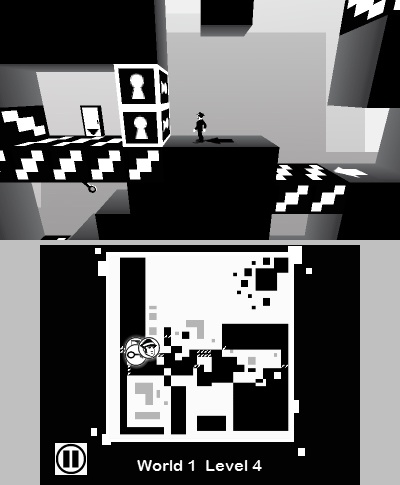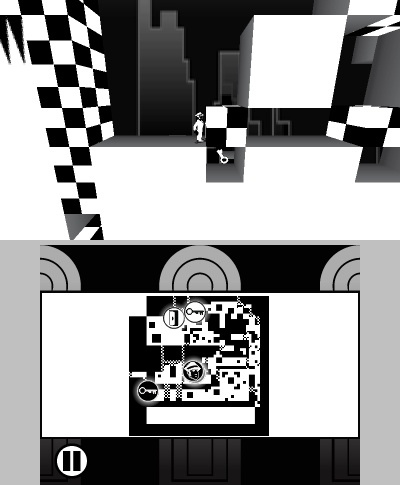In the past few years, we've seen many successful console releases based on titles that were originally free-to-play online Flash games. Games like Alien Hominid and Super Meat Boy used their successful Flash outings as a foundation for expansion, adding additional features and ideas that took full advantage of the hardware they were using. Shifting World has similar origins: it sprung from a series of Flash games called Shift (which have seen numerous ports to smartphones and even PSN), but adds numerous new twists and elements incorporating the capabilities of the 3DS hardware. Unfortunately, these additions aren't as well thought out and implemented as they could be, resulting in a game that ultimately falls short of the charming little puzzles that spawned it.

Shifting World finds its enigmatic hero trapped in a strange, two-toned series of mazes by the equally mysterious Duke of Shadows. The reasons this hero is stuck in this world aren't immediately clear, but what is obvious is that he must find a way to extract himself from this monochrome mess as swiftly as possible. But just rushing through these platforming environments isn't going to accomplish much of anything: you will soon come up against obstacles and structures that seem insurmountable. That's where Shifting World's unique gameplay gimmick comes into play. When you press the shift button, the room does a 180-degree flip and changes its structure so that the foreground sinks into the background, and vice versa, creating passageways and platforms that weren't there previously.
Shifting has other uses, too: certain platforms and elements in the environment react to shifting in their own ways, while some floors prevent shifting entirely. Keys and switches are also scattered throughout stages, opening new paths to different parts of the level upon collection and proper activation, respectively. Not everything in these mazes is beneficial or benevolent, however: traps, such as instant-kill spikes, also exist to turn simple puzzles into precarious predicaments if you aren't careful. It's a clever take on the platform-puzzle formula, and on paper, it sounds like a recipe for a brain-boggling good time.
Yes, the concept is proven to be very fun--in its original Shift incarnation. Unfortunately, many of the "advanced" new elements that Shifting World tosses into the mix only serve to hamper the game instead of making it more interesting.
The original Shift games were centered on single-screen rooms that let you see the entire layout of the maze at once. Shifting World builds on this concept by introducing multi-screen mazes. The section of the maze you are currently exploring is displayed on the top screen, while the lower screen shows a mini-map of the entire maze. While this doesn't sound like much of a problem, the execution is flawed, since certain elements aren't properly marked on the mini-map. In particular, hazards aren't clearly displayed, meaning that you will more than likely make a jump that looks OK from the bottom view, only to be greeted by the business end of some very pointy terrain. The larger maps also prove frustrating when you're trying to use various devices to open up parts of the maze. For example, when you collect a key that removes some obstacles, it can sometimes be tough to figure out exactly where things disappeared from, leading to more frustrating wandering about.

Shifting World has a very striking appearance. The strictly black-and-white visuals lend a distinct, unique feel to the game's stark maze rooms, and the 3D effect helps you better visualize the layout of the room before a shift takes place. However, the choice of monochrome visuals also has an unintended side effect: it makes everything look the same. Sometimes it's hard to tell if you've already visited a certain part of the maze or not, simply because the lack of color leads to areas looking a lot alike. Even with a mini-map, it's easy to get lost in these rooms for annoyingly long stretches of time.
Making matters worse is that any damage results in having to completely restart the stage, meaning yet more time potentially spent meandering around and growing more annoyed. To top it off, every now and then you experience a sudden bout of input lag. Shifting World isn't terribly reflex-heavy, but in the sequences where you do need a bit of careful timing, losing all of your progress in a room to a delayed button input is rage-inducing.
Shifting World is certainly an interesting game--it's based on a solid concept and offers up some very clever puzzles. It has all the earmarks of a classic puzzler that keeps you coming back for more. That's what makes it so frustrating: it's clear there's a good game under the surface, but it's lying at the bottom of a deep pool of frustrating, ill-conceived design decisions. It certainly looks appealing from above, but most players aren't going to struggle with holding their breath long enough to get to the prize underneath.